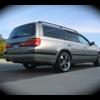Stagea S1 Not Starting
Announcements
-
Similar Content
-
Latest Posts
-
I will rebutt this and the preceding point from Dose....but without doing any calcs to demonstrate anything and without knowing that I am right or wrong. But... The flow capacity of a fluid transfer system is not limited by the smallest orifice or section of conduit in that system, unless it is drastically smaller than the rest of the system. OK, I use the word drastically perhaps with too much emphasis, but let's drill down on what I really mean. The flow capacity of the system is the result of the sum of the restrictions of the entire system. So, to make an extreme example, if you have a network with 3" pipe everywhere (and let's say a total length of only a few metres) and that 12mm ID restriction of the oil filter connection being the obvious restriction, then for any given amount of pressure available, the vast majority of all the pressure drop in the system is going to occur in the 12mm restriction. But.... increase the length of the 3" pipeline to, say 1000m, and suddenly the pipe pressure loss will likely add up to either be in the same order of magnitude, possibly even exceeding that of the 12mm restriction. Now the 12mm restriction starts to matter less. Translate this to the actual engine, actual oil cooler hose sizing, etc etc, and perhaps: The pressure loss caused by flowing through the narrow section (being the 12mm oil filter port, and perhaps any internal engine oil flow pathways associated with it) is a certain number. The pressure loss through, say, -12 hoses out to the cooler and back is negligible, but The pressure loss through -10 hoses out to the cooler, at the exact same length as the above, starts to become a decent fraction of the loss through the 12mm stuff at the filter port. Maybe even it starts to exceed it. I could actually do these calcs if I knew 1) how much oil was actually flowing in the line, 2) gave enough of a f**k to do things that I hate doing for work, voluntarily for a hypothetical discussion. Anyway - I reiterate. It's not the narrowest port that necessarily determines how much it can all flow. It is the sum. A long enough length of seemingly fat enough pipe can still cause more loss than a semmingly dominant small bore restriction.
-
To pick up what Dose is putting down. Not a lot of point running a huge hose if the motor is still restricted to the smaller size... It's only capable of flowing so much at that point... *Waits for GTSBoy to come in and bring in the technicalities of length of pipe, and additional restriction from wall friction etc etc*
-
Hooley Dooley these things have some history! If i sell them they will need a certificate of providence to prove they have been in the hands of verified RB20 royalty! They have been stored in a plastic tub, away from sunlight and moisture. They are in mint condition. And they will stay that way, as i have sprung the money for a set of shockworks coilovers. I'm just working on getting them in at the moment, after rebushing the rear of the car, and while the subframe was out i welded in the GKtech reinforcement bracing as well. They will get a workout at Ararat King of The Hill in November. I ran 48s on the short course there a few months ago, and i am hoping with new bushes and shocks in the rear i can launch a bit harder. There was a fair bit of axle tramp when i tried too hard off the line. a few of the corners had dips mid way which also made the car feel a bit unsettled, hopefully this will help there too.
-
By Dose Pipe Sutututu · Posted
Food for thought, the stock oil filter thread is a 3/4-16 UNF, which has an ID of about 10 to 12mm (according to ChatGPT lol). Now compare than to an 10AN, which has an ID of about 14mm (Raceworks is 14.2mm, Speed flow is 14.27mm). -
Yep, totally get that. However hooking in for Generator back up is only a few hundred bucks for the wiring. You could put a couple of those in (for different circuits explicitly) and run a couple of baby generators. Bonus, you can balance them across different circuits, and now have backups in your backup. I'm looking at buying places that won't even have water etc, and I don't mind the idea of getting off the electric grid either, even with everything you've said. This country already has enough power outages that even the mains grid isn't that reliable anymore. I do agree though on spending a bit more to get better gear, and to add some extra redundancy in to the system too.
-







Recommended Posts
Create an account or sign in to comment
You need to be a member in order to leave a comment
Create an account
Sign up for a new account in our community. It's easy!
Register a new accountSign in
Already have an account? Sign in here.
Sign In Now